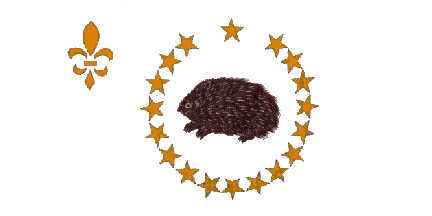
by Luc Baronian

Last modified: 2007-02-24 by phil nelson
Keywords: madawaska | new brunswick | maine | quebec | canada | porcupine | stars: 6 red | eagle |
Links: FOTW homepage |
search |
disclaimer and copyright |
write us |
mirrors
See also:
Bicentennial flag

by Luc-Vartan Baronian
This image was made from a picture of one of the flags from the tremendous collection of Donald Gauthier. The research was also entirely done by Donald, I have no credit for this part.
The flag was made for the opening of the bicentennial (1785-1985) of Madawaska, adopted by the Council of Saint-Basile (New Brunswick) and approved by the Société historique du Madawaska. This name of Micmac origin is formed with Madawas (porcupine) and Kak (place), so the country of the porcupine, the emblem of Madawaska. The field is white : for peace, joy and friendship. In the canton, a fleur de lys that reminds the origins of New France (Acadie). In the center, a porcupine recalls the oldest origins of Madawaska, to perpetuate the memory of the Amerindians who welcomed in 1785 the founders of Madawaska. All around the porcupine, 18 stars representing the municipalities of the region or county of Madawaska (New Brunswick).
Luc-Vartan Baronian, 2 February 1998
Qouting from caption of letter shown at Maine Memory Network (unimportant in itself):
In 1828 Charles S. Davies of Portland, wrote Samuel Cook, land agent at Houlton, concerning State and Federal support for Aroostook settlers in the Border Dispute with New Brunswick, as well as other matters. In the letter he refers to (John) Baker who, in 1827, raised a flag depicting an eagle partially surrounded by stars, in a community that was later know as Fort Kent. New Brunswick authorities arrested Baker because they considered the act to be seditious.
On John Baker upperstjohn.com notes (his flag mentioned towards the end, relevant text on tombstone clickable):
This leads to a detailed article:
Under His Own Flag: John Baker's Gravestone Memorial in Retrospect
by George L. Findlen.
(Originally published in French, 2002,
bibliographical info provided.)"Geraldine Tidd Scott tells the story briefly.(5)
On July 4, 1827, John Baker and about fourteen of his neighbors celebrated Independence Day. At the [Western side of the] confluence of the Meruimticook [Baker Brook] and St. John Rivers, on land conveyed to Baker by Maine and Massachusetts, Baker erected a flag staff. Two of the French settlers assisted him in a traditional flag- raising ceremony. A flag made by Sophia Baker, bearing a representation of the national eagle partially surrounded by stars, was raised. An address was followed by a feast. A French fiddler, Bellony Terrio [Bénonie Thériault], had been hired for the occasion and some of the Acadians from Madawaska were guests. In the evening, a ball at the home of James Bacon [whose house was on the Eastern side of the confluence of Baker Brook and the Saint John River], at which by invitation many of the French settlers were present, concluded the festivities of the day.
Were the flag raising merely a proud commemoration of Baker's origins, nothing might have come of the event. But the event was not about the past; it was about the present and future. The event was not about diversity; it was about which country would have control of the Upper Saint John River Valley. As Scott points out, "there is no doubt that this particular gathering had also as its purpose the exercising of jurisdiction." On the 25th of July, militia adjutant Francis Rice wrote to justice of the peace George Morehouse, complaining that there was "disorder amongst the people, occasioned by Baker and others in the upper settlement."
Rice's letter got results. The New Brunswick attorney general directed Justice of the Peace George Morehouse to investigate the matter. Morehouse went to the Madawaska settlement, found a person who had been present at the flag raising, and recorded the following sworn testimony from William Feirio [Guillaume Thériault]:
Baker and the other American citizens then raised a flag staff, and placed the American flag thereon; that the said Baker then declared that place to be American territory, which he repeated to this deponent and other French settlers then there, and that they must for the future look upon themselves as subjects of the United States, who would protect them, and him in what he was doing.
Morehouse then went to Baker's house on 7 August 1827. Here is part of what took place.
I pointed to the flag, and asked Baker what that was. He said, "the American flag, Mr. Morehouse: did you never see it before, if not, you can see it now." I asked him who planted it there: he said, "he and the other Americans there." Bacon was present at the time: I required him in His Majesty's name to pull it down. He replied, "no, I will not; we have placed it there, and we are determined we will support it, and nothing but a superior force to ourselves shall take it down; we are on American territory; Great Britain has no jurisdiction here; what we are doing we will be supported in; we have a right to be protected, and will be protected, in what we are doing, by our Government."
Baker was arrested in the following month. Eight months later, he was tried before a jury in Fredericton, found guilty of high misdemeanor, fined 25 pounds, and jailed for two months (or until he paid the fine). George Morehouse, in his testimony at Baker's trial, described the flag as "a white flag, with an American eagle and semicircle of stars, red."
This is the incident memorialized on the back of John Baker's headstone.
Jan Mertens, 18 November 2005